Menu

Precision agriculture has grown from 35% to over 70% of U.S. cropland in a decade. This shows how important precision agriculture sensors are in modern farming.
Since the 1960s, farming has seen huge improvements with technology. Now, thanks to better computing, cheaper electronics, and advanced data analysis, we have smart farming.
Smart farming uses high-tech sensors to better use farm resources. It collects and analyses detailed data for smart decisions that change how farms are managed.
Our guide looks deep into precision farming, covering over 60 pages. It shows the key work of Dr Pierre Robert from the 1980s. We break down the precision agriculture process into collecting data, using it, deciding, and acting.
We’ll focus on Farm21, known for helping farmers use precision agriculture. They offer tools like the Precision Farming Worksheet. This tool makes adopting precision farming easier. Our guide will explore how precision agriculture sensors are shaping the future of farms.
Precision agriculture is a big change in how we farm. We now use precise data to make farming more efficient. It all started in the 1960s with grid planting, focusing on specific areas. Today, it’s about setting clear goals, knowing what data we need, and how to use it.
Farms are bigger now, which makes it hard to keep track of everything. Precision agriculture uses technology to collect and analyse data automatically. Sensors that monitor crop conditions in real-time are a key part of this.
In Missouri, there’s been a big step forward with GPS for farming. Regular GPS is accurate within about 300 feet. But, with special correction, it can pinpoint locations within 3 to 10 feet. This level of accuracy is really important for farming, and the correction beacons are free thanks to the Coast Guard.
In the same state, they’re doing more precise soil sampling. For better understanding the soil, they only look at small parts of fields. This helps in making smarter choices about what crops to grow.
Remote sensing is another handy technology for farmers. It uses data to show if plants are stressed by lack of water, nutrients, or if they’re sick. It can also find weed areas, pests, or parts of the field that are damaged. Adding Geographic Information Systems (GIS) helps store and analyse this data, which is useful for planning and managing crops.
“In Missouri, the variation in yield levels for corn and soybeans typically remains at a ratio of 2 to 1,” illustrating the fluctuations dependent on precise agricultural practices.
Agricultural sensors really help in making farming more efficient. They lead to better results and help save money. For more on how this works and its benefits, check out a valuable guide here.
An example from Missouri shows how well precision agriculture works. It proves the benefits of using the latest technology in farming. This smart approach really helps in managing farms and keeping crops healthy.
In precision agriculture, sensors are key for gathering important data. This data can improve crop yields and help use resources better. Let’s look at soil sensors, weather sensors, and crop monitoring tools used in farming today.
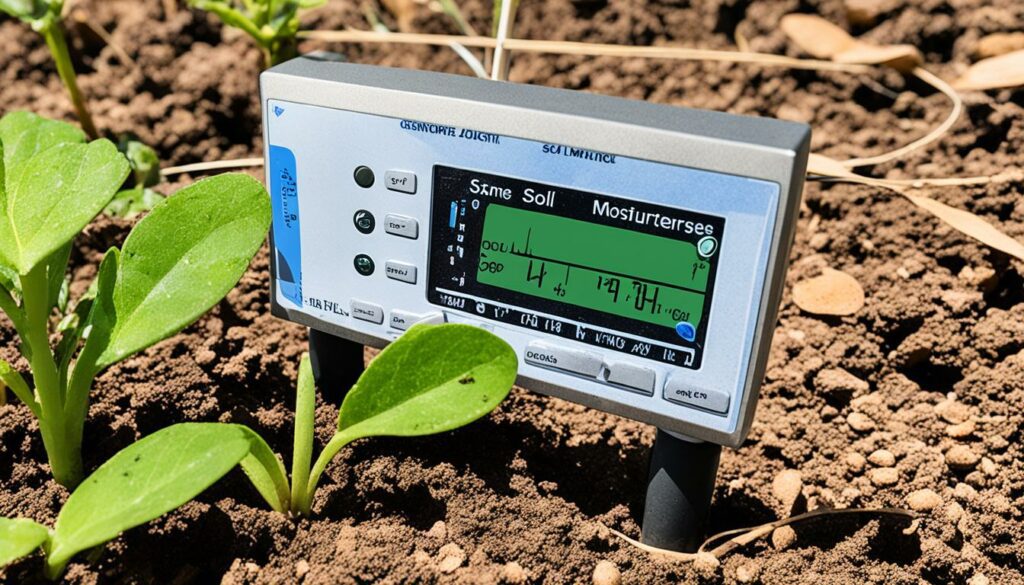
Soil sensors give farmers detailed info on the soil. They check moisture, temperature, and nutrients. They help in planting and watering. Types include mechanical, dielectric for moisture, and electrochemical for nutrients. With these, farmers make their soil better for crops. They also save water and fertilisers.
Weather sensors help with crop protection. They measure temperature, humidity, and more. This helps farmers adjust to weather changes. It lowers the chance of crop damage. These devices connect wirelessly. This allows for easy monitoring from phones or computers.
Crop sensors focus on plant health. They check things like chlorophyll and leaf moisture. They help find and fix problems quickly. This ensures a good harvest. Optical and IoT sensors can track plant health in real time. This gives farmers advice to make their crops better.
To sum up, using soil, weather, and crop sensors is changing farming. These technologies help farmers gather and understand data better. This lets them farm smarter, produce more food, and meet demands.
Using precision agriculture sensors can greatly improve farming. They help farmers grow more crops while using less water and fewer fertilisers. This approach supports both enhanced productivity and sustainable farming practices.
These systems use high-tech tools like GPS, drones, and satellites to gather data. This data covers crop growth, weather, and changes in the environment. By using this information, farmers can optimise how they use their land. This helps ensure we have enough food and fights global hunger.
These systems cut costs by using resources more efficiently. They also reduce the need for pesticides and limit farming’s impact on the weather. By doing this, they help crops reach their full potential. All these benefits are vital for making farming more sustainable.
For precision farming to work, farmers need special tools, software, and trained staff. GPS helps map out fields and apply seeds and fertilisers precisely. Geographic Information Systems (GIS) are also key. They create maps that show farming areas in detail. This is crucial for good field management.
Drones play a big part in precision farming too. They check on crops and fields from the air. This is quick, eco-friendly, and very effective. Satellite images are also important. They give detailed information on crop health, pests, and nutrients.
Another useful tech is Variable Rate Technology (VRT). It helps farmers use resources like water and fertilisers more wisely. By combining all these tools, farmers can boost their productivity. They can do this in a way that cares for the environment too.
Precision agriculture sensors are crucial for modern farming. They turn physical conditions into electronic signals that show real-time details. By using this data, farmers can improve how they use resources, boost productivity, and protect the environment.
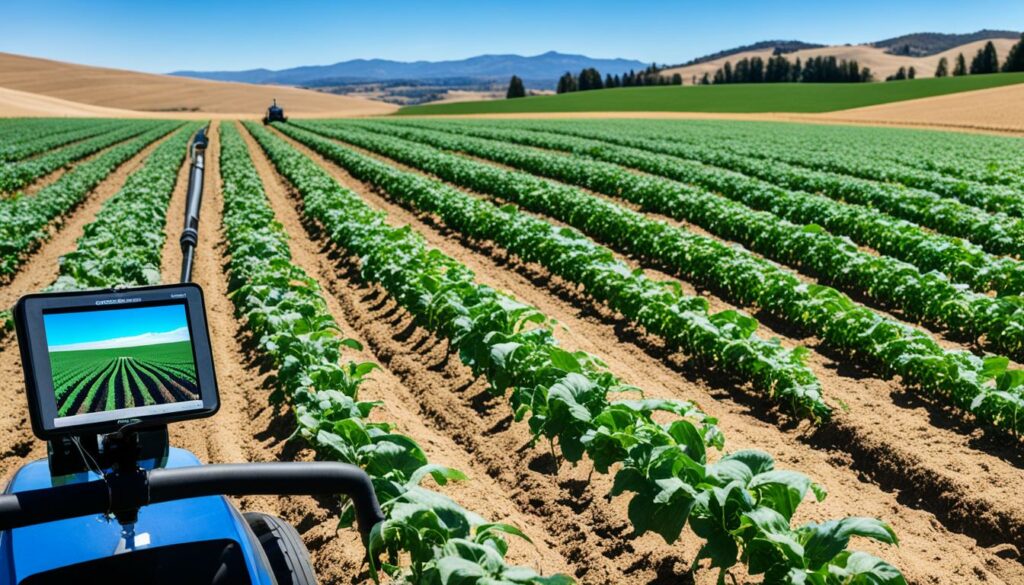
Sensors in precision agriculture pick up on things like soil moisture and how the crops are doing. For instance, soil sensors check moisture levels. This information is then used to figure out the best conditions for the farm.
The strength of precision agriculture is in collecting vast amounts of data and then analysing it. From soil to the weather, these sensors don’t miss a beat. This approach not only forecasts crop yields but also catches farming problems early, like diseases. It even helps to use water and fertiliser smarter.
| Parameter | Sensor Type | Application |
|---|---|---|
| Soil Moisture | Soil Sensor | Optimising irrigation |
| Crop Health | Crop Sensor | Detecting diseases and stress |
| Environmental Conditions | Weather Sensor | Adjusting protection strategies |
California is a key place for food in the US, growing lots of fruits, nuts, and veggies. Thanks to smart data use, farmers there are making better choices. For example, using machine learning with almond yield data makes predicting harvests accurate. The same goes for lettuce, where cutting-edge farming helps farmers do more with less.
Smart farming equipment is getting more important. It’s key to know what you want from your farm first. Think about your farm’s needs. Then, pick the right sensors to help reach your goals.
John Deere’s See and Spray is an example of a great technology. It shows how sensors can be used to precisely apply pesticides. This can save money and help protect our environment.
It’s vital to choose the right smart equipment for your farm. Look for sensors that match what your farm needs. For example, some sensors can check the colour of plants and soil. This makes soil analysis better.
Other sensors can tell you about the nutrients and pH of the soil. This is important for using fertiliser efficiently. Mechanical soil sensors are also useful. They can look at how hard the soil is. This tells you how well the soil can handle farming activities.
There are also soil moisture sensors. They show how much water the soil has. This is key for managing water when you irrigate. Location sensors, which use GPS, can also help. They make precision farming even more accurate.
Using smart farming equipment also means handling lots of data well. A good data system can organise and use all the data from the equipment and sensors. GPS is not just for precision farming. It’s great for tracking livestock and guiding vehicles on the farm.
Finally, investing in smart farming tech boosts farm productivity. It also helps farms be more sustainable. This is thanks to using data in real-time to manage resources in the best way.
Choosing the right sensors for precision agriculture is key. It all starts with knowing what your farm needs and what you can afford. These sensors can make your farm more efficient and profitable by giving you important data.
First, figure out what your farm needs. You must look at crop health, water requirements, and how to manage your fields. Different sensors, like RGB, multispectral, hyperspectral, and thermal, show various farming aspects. Knowing this helps pick the sensors that meet your goals, like better crops or meeting rules.
Rules and policies also shape your sensor choices, especially where the tech comes from. For example, equipment from DJI might have use limits for some US government groups. Understanding these rules is a big part of picking your sensors.
Knowing what your farm needs, now you must align your budget with required technology costs. For UAV farming sensors, here’s a breakdown of what you might need and how much it could cost:
| Sensor Type | Number of Bands | Bands Captured | Estimated Cost |
|---|---|---|---|
| Visual (RGB) | 3 | Red, Green, Blue | £1,000 – £1,500 |
| Multispectral | 5 | Blue, Green, Red, Red Edge, Near InfraRed | £2,500 – £8,500 |
| Hyperspectral | 100+ | Multiple Narrow Bands | £15,000 – £50,000 |
| Thermal | 1 | Infrared | £3,500 – £6,500 |
Don’t forget, high-tech sensors do cost a lot. But they can really boost your farm’s output and resource use. Make sure to include costs for handling data and potential maintenance when planning your budget.
Precision agriculture sensors are proving their worth in many parts of the world. For example, in Georgia, USA, they showed that using Variable Rate Irrigation (VRI) on cotton fields increased the yield by 8%. It also cut water use by 15%. This shows how these sensors help farms be more sustainable.
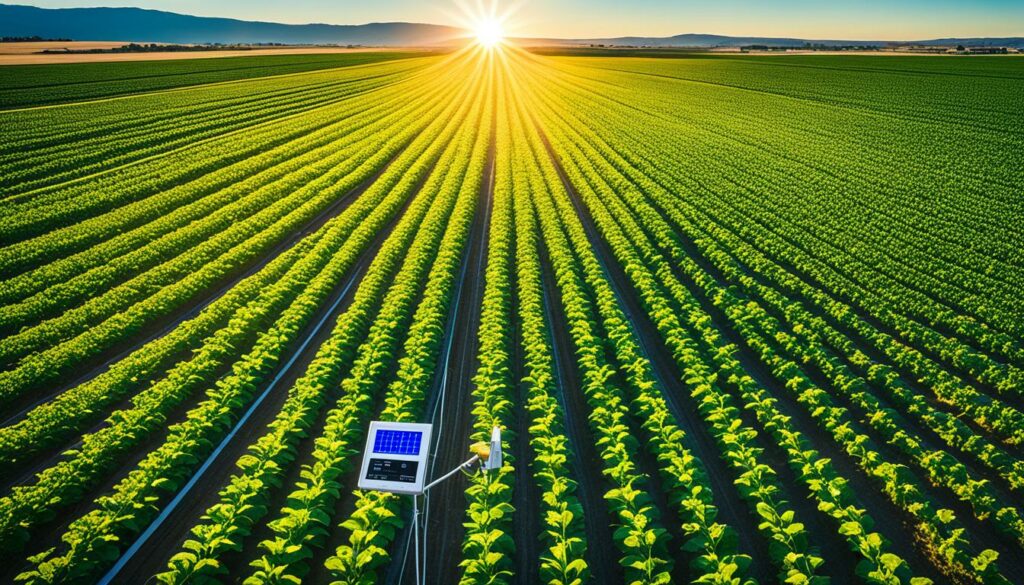
In Australia, drones with special cameras and spray nozzles cut herbicide use by 90% in wheat fields. This is a huge step forward in managing crops wisely. In India, a company used satellite images and AI to predict sugarcane yields more accurately. They improved forecasting by 20% thanks to these advanced technologies.
Kenyan farmers saw a 30% boost in their maize production by using a soil health monitoring app. This shows how pairing sensors with mobile tech can solve farming issues. In Eastern India, monitoring water use helped cut down on gases that harm the planet. This highlights the green perks of using precision agriculture.
An Irish dairy farm used tech to better track and manage animals, and it led to a 10% more milk. A farm in Singapore managed to use 95% less water by growing crops in a smart, vertical system. These examples clearly show the broad success of sensor tech in agriculture.
Here’s a brief table showing the key findings from these case studies:
| Region | Technology Implemented | Outcome |
|---|---|---|
| Georgia, USA | Variable Rate Irrigation (VRI) | 8% yield increase, 15% water reduction |
| Australia | Multispectral drones | 90% reduction in herbicide use |
| India | Satellite imagery and AI | 20% increase in forecasting accuracy |
| Kenya | Mobile soil health monitoring | 30% improvement in maize yield |
| Ireland | Livestock tracking | 10% increase in milk production |
| Singapore | Vertical hydroponic system | 95% reduction in water use |
These stories underline the concrete benefits of using advanced sensors in farming. They make a strong case for embracing this technology in agriculture today.
Modern farming is changing, thanks to IoT devices. These systems connect different parts of the farm. They help equipment talk to each other, making farming more efficient. This connection allows for automated tasks and keeps an eye on crops.
Today’s farming faces tough challenges: growing populations, changing climates, less rain, and more food needed. IoT devices tackle these issues by collecting and analysing data in real time. This makes farming smarter, using resources more precisely.
IoT devices include sensors that check soil for nutrients and moisture. They also measure things like air and soil temperature, rainfall, and wind speed. This data lets farmers know exactly what their crops need. With smart sensors, they can watch over their fields from afar. They can spot and deal with pests quickly, protecting their crops and the environment.
Various types of sensors used in interconnected farming systems include optical sensors, mechanical soil sensors, location sensors, electronic sensors, airflow sensors, and agriculture sensors IoT.
These smart sensors don’t just help with crops. They also track animals and keep an eye on their health. With GPS, farmers know where their livestock are. It also helps with guiding vehicles on farms. Plus, temperature sensors watch over the weather and the farming machinery.
Geofencing is another great use of IoT in farming. It warns farmers when something leaves or enters a certain area. Digital Matter’s devices help farmers run their farms better. This leads to bigger harvests and better farm work.
| Sensor Type | Function |
|---|---|
| Electrochemical sensors | Soil nutrient detection |
| Dielectric soil moisture sensors | Measure soil moisture levels |
| GPS sensors | Livestock tracking and vehicle guidance |
| Temperature sensors | Monitor ambient conditions and mechanical assets |
| Accelerometer sensors | Detect movement variations and vibrations |
The future of farming is set to change dramatically. Thanks to new tech and better use of data, farming will become smarter and more efficient. This change will see the use of new tools and systems that make old farming ways much more effective.
AI and machine learning are making data analysis better for farming. John Deere’s operations centre uses these to make smarter decisions. Agmatix, on the other hand, uses analytics for field testing and managing crops. Thanks to these technologies, farmers can turn a mix of data into useful actions, making farming more efficient, cheaper, and kinder to the environment.
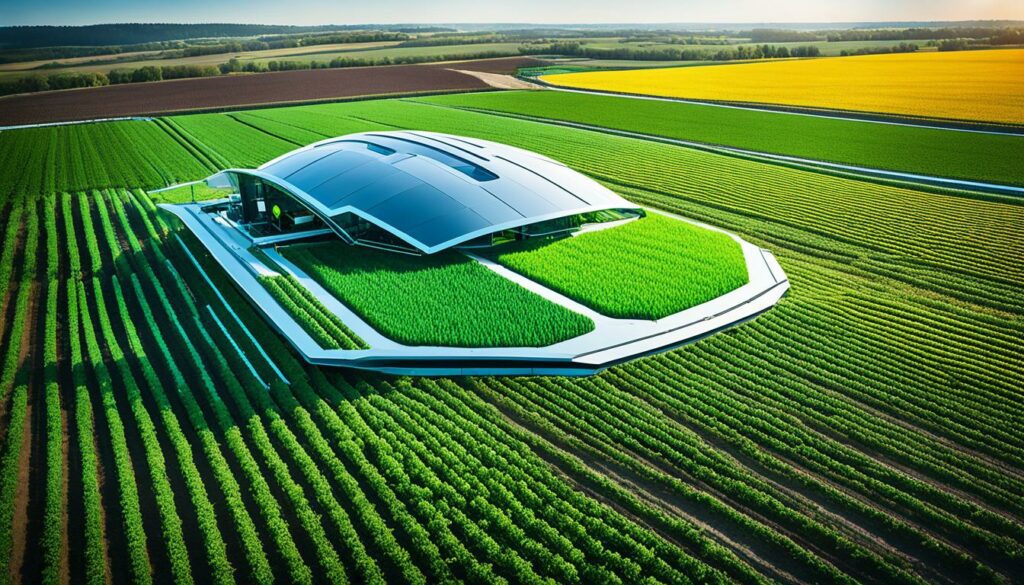
There’s a clear trend in farming towards using more high-tech tools. Satellites and drones give instant updates on crop and soil conditions. GIS helps farmers manage fields effectively. And, automated machines and robots from companies like Precision Planting by AGCO are improving how seeds are planted, boosting farming efficiency.
| Technological Advancements | Benefits |
|---|---|
| AI and Machine Learning | Improved data analysis and predictive capabilities |
| Remote Sensing | Real-time monitoring of crop health and soil moisture |
| Automated Machinery | Optimised resource use and reduced human error |
| Big Data Analytics | Actionable insights and trend prediction |
The precision farming market was worth USD 9.4 billion in 2022. It’s expected to grow by 12.6% every year from 2023 to 2030. This rise comes from more people realising the benefits of new farming technologies, especially in places like North America and Europe. With more farmers using data in their planning, we can expect more sustainable and productive farming around the world.
“The future of precision farming hinges on the ongoing collaboration between tech giants, researchers, agronomists, and farmers. This synergy is fundamental to ensuring global food security and sustainable agricultural practices.”
The use of precision agriculture sensors is key for sustainable farming. These sensors give real-time updates on weather, soil, and crop conditions. This data helps farmers use resources better, reducing waste and harm to the environment.
These sensors boost crop production by helping farmers grow more and better crops. They are essential in today’s farming to meet the growing demand for food. They also help cope with the effects of a changing climate.
Various sensor types, like GPS and temperature sensors, track different aspects of farming. GPS helps in tracking animals and guiding vehicles. Agricultural temperature sensors maintain proper conditions and help in equipment monitoring.
This technology leads to significant sustainable benefits. It can increase crop production by 4% and make fertiliser use 7% more efficient. It also cuts down on using harmful chemicals by 9%.
Precision agriculture also decreases fossil fuel use by 6% and lowers water consumption by 4%. It has saved enough water for 750,000 Olympic pools and saved 2 million acres from farming.
| Benefit | Percentage Increase/Decrease |
|---|---|
| Crop Production | +4% |
| Fertiliser Placement Efficiency | +7% |
| Herbicide and Pesticide Use | -9% |
| Fossil Fuel Usage | -6% |
| Water Consumption | -4% |
The future of precision agriculture is bright. Its full adoption could mean a 6% increase in productivity. It might also enhance fertiliser use by 14% and cut water use by 21%. This could avoid 17.3 million metric tons of CO2 emissions, showing its great benefit.
Precision agriculture has many advantages, but taking full advantage has its own set of hurdles. It’s crucial to tackle technical issues first. Knowing the complexities helps in finding the right solutions.
Running the advanced gear of precision agriculture needs skilled staff. This means extra training might be necessary for farmers. There’s also a shortage of pros who really understand how to handle data, connect tech, and make the best of new tools. Education and collaboration are key to solving these issues. Working closely with tech providers who offer solid support and advice can also help a lot.
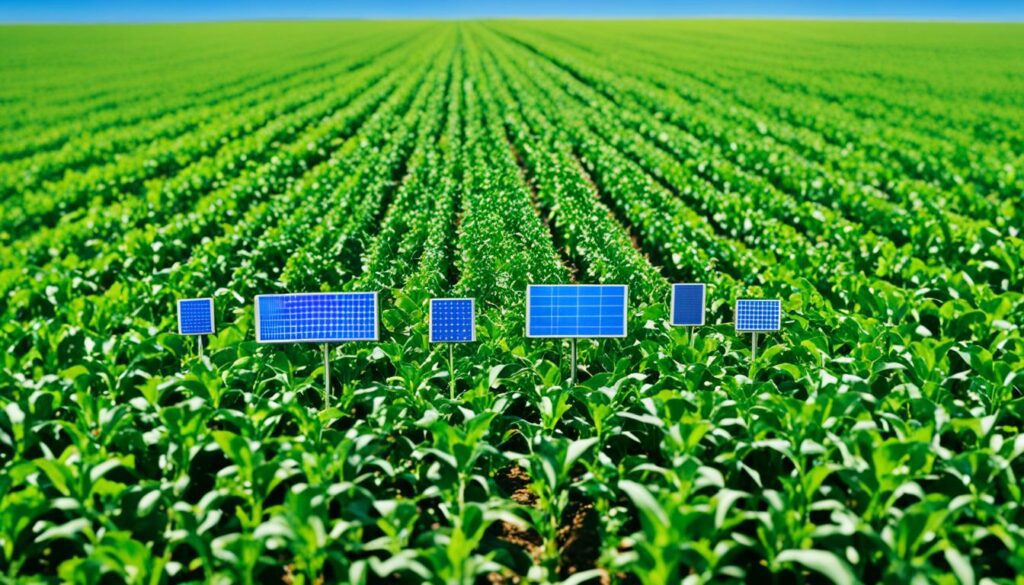
Getting into precision agriculture can be pricey because it requires specialised tools and tech. It’s not just the upfront costs, but also the upkeep and future upgrades. Finding ways to save, increase flexibility, and boost productivity is important. One option is using Folio3’s services for better cost management. Thinking strategically and focusing on long-term benefits helps with the financial load.
With more data being chipped in from farm tools, keeping that info safe is crucial. Protecting sensitive data is important for trust and staying within rules. It’s recommended to use strong encryption, safe data storage, and do regular security checks. By putting data privacy first and having strict security steps, farmers can protect their data and enjoy what precision agriculture has to offer.
| Challenge | Solution |
|---|---|
| Technical Challenges | Ongoing education and collaboration with technology providers |
| Cost and Maintenance | Evaluating total cost of ownership and resource augmentation services |
| Data Privacy and Security | Implementing robust encryption, secure storage, and regular audits |
Precision agriculture sensors are used differently in small and large farms. Each type of farm uses this technology to meet their own special needs.
In small farms, the focus is on technology that is both cheap and does a lot. Sensors here might check soil moisture and nutrients. They use things like optics and electrochemistry. This way, farmers can make good decisions without spending a lot on big setups.
On the other hand, big farms use a wide range of sensors. They have devices like GPS for tracking livestock and guiding vehicles. There are also sensors for watching over the temperature and predicting machine repairs. These tools are great for keeping an eye on large fields and managing crops well through lots of data.
The fact that these sensors can work in both big and small farms shows how important they are. With the world growing in population and facing climate change, farming needs to be more efficient. Using technology, both big and small farms can do better at growing food in a way that helps the planet.
| Farm Scale | Sensor Types | Key Benefits |
|---|---|---|
| Small-Scale | Optical, Electrochemical | Affordability, Specific Targeting |
| Large-Scale | GPS, IoT, Accelerometer | Extensive Data Integration, Efficient Management |
So, whether we’re talking about high-tech sensors in big farms or simpler tech in small farms, what really matters is using them smartly. This means using the right sensors for the job, and that’s how each farm can do its best.
The future of farming is changing with precision agriculture sensors. These tools use new technologies like AI, IoT, and robotics. They make farming better, cheaper, and kinder to the planet. With them, farmers save money and help the environment by lowering their carbon footprints.
Precision agriculture is not just for one place; it’s global. It’s used in over 100 countries, with growth seen in Asia Pacific and South America. Even in places just starting, like Africa, it’s showing its worth. This shows that high-tech farming is for everyone, no matter where they are.
There are challenges, like handling lots of data and the cost of new tech. But, the results are impressive. Farmers have seen their yields go up by as much as 25%. They make their money back in just a few years. This shows the clear benefit of using these advanced tools.
As people want to know more about where their food comes from, precision agriculture is ready to answer. It can provide the transparency consumers ask for. It’s a win-win, for the farmers and the people who buy their products.
So, the increasing use of precision agriculture sensors is a big deal for farming. It helps overcome challenges, offering a path to a better, more sustainable future. For agriculture today, using these high-tech tools is not just a good idea. It’s necessary, ensuring growth and care for the planet going forward.
Precision agriculture sensors monitor farming conditions. These include soil state, weather, and crop health. They provide data for smart farming decisions.
Soil sensors check things like how wet the soil is and its nutrients. This helps know the best time for planting and when to water the crops. It makes sure the soil is perfect for growing crops.
Weather sensors record things like air temperature and if it’s going to rain. Farmers use this to protect their crops from the bad weather. It also helps them plan when to water the fields.
Crop sensors look at how healthy the plants are and if they’re stressed. This can show if there’s a disease or bugs attacking the plants. It helps farmers save their crops early, which can make the harvest better.
Precision agriculture uses resources like water in a smart way. This allows farmers to grow more crops without wasting anything. It’s all about making decisions based on accurate data.
Precision agriculture sensors change things on the farm into signals we can read. These signals help us see how the farm’s doing. After that, we look at the data to make choices that help the farm grow better.
Getting precision agriculture sensors starts with knowing what you want to achieve on the farm. Then, choose the right technology and put the sensors in place. Everything is done to make farming decisions easier and better based on the data.
To pick the best sensors, think about what your farm needs. Also, look at how much you can spend and what you might get back from the investment. The sensors should be able to measure what you want to know clearly and often.
Yes, there’s FruitNL, where Farm21 sensors made watering crops better. Stories like these show how using the right technology can really help farming.
IoT devices link different sensors and machines on the farm. This link means the farm can work smarter and more connected. It’s all to keep crops in the best condition.
The future will see AI and machine learning doing more work on the farm data. We’ll also use more tools that can sense things from far away. These changes will make farming even better and more focused on using data.
Precision agriculture sensors help use resources in a careful way. This means less waste and impact on the environment. They keep farming in line with looking after the Earth for the long term.
There are hurdles like the technology being hard to manage, it being expensive, and worries about keeping data safe. Dealing with these involves learning more, looking at the full cost of using the technology, and being careful with data security.
Smaller farms might use simpler, cheaper tech to understand and control their space. Bigger farms use lots of different sensors and devices to watch over their large area efficiently. Both kinds of farms find ways to use precision agriculture that suit them best.